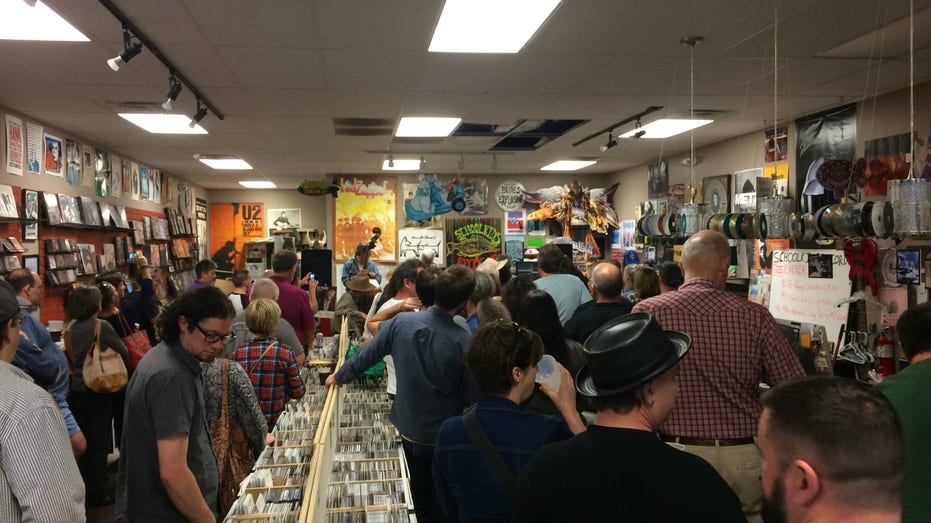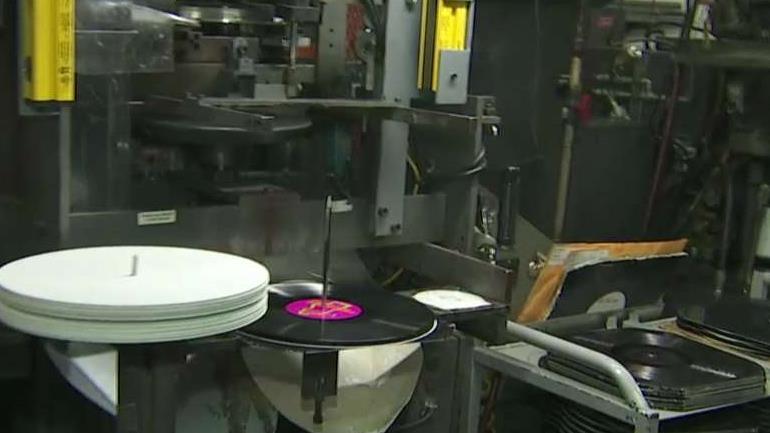Vinyl record revolution spins on
Millennials and Gen Z music fans accounted for half of vinyl sales in 2018
The vinyl revolution’s extended play has surprised and delighted many industry players and fans despite digital dominance in the music business. Vinyl record sales peaked in the disco days of the 1970s and flatlined twice over the past 30 years, but the resilient format is no novelty record, as it has been growing for more than a dozen years.
This would have been inconceivable two decades ago, when first CDs, and then digital downloads, nearly rendered LPs extinct. Nielsen Music reports sales of vinyl albums in 2018 hit the highest since it began keeping records in the early 1990s. Nielsen analyst David Bakula tells FOX Business he “fully expects” growth for the format in 2019 versus ‘18.
Russ Crupnick, managing partner at entertainment industry research firm MusicWatch, finds fans of all ages like to connect with vinyl in ways they can’t with their streaming playlists: “People like touching and feeling vinyl, it’s a sense that (an album) is a little sculpture; there’s a connection to the artist and the music, and for some, the belief in the fidelity. Vinyl has this unique niche in the hearts of a lot of music fans that no other format has.”

Don’t Call it a Comeback
Annual LP sales fell below one million in the early part of this century but have risen phoenix-like and are poised to overtake CD sales revenue, and possibly unit sales, in the not-too-distant future. 16.8 million albums sold is a small part of the industry given there were 618 million album streams in 2018, according to Nielsen Music. But it is notable since vinyl sales grew while CDs dropped sharply and digital album purchases also declined.
MOTLEY CRUE: 'THE DIRT' ON WHY THE REUNION TOUR WILL RAKE IT IN
It’s not just nostalgic Baby Boomers and Gen Xers fueling this trend by snapping up platters from local indie record stores. In fact, data from MusicWatch found Millennials and Gen Z music fans accounted for half of vinyl sales in 2018. Boomers, who perhaps never gave up their record collections, were the smallest demo.
Josh Friedlander, senior vice president, research and economics at the Record Industry Association of America (RIAA), notes the best sellers this year are not just classic rock but include Billie Eilish and Taylor Swift, who skew toward younger fans. Friedlander adds that at midyear, vinyl sales were up 13 percent over 2018.
The vinyl renaissance has also been a boom for many of the companies that literally make the magic happen. Record Technology Inc. (RTI) in Camarillo, California, presses records around the clock five days a week to meet burgeoning demand. Don MacInnis started working at RTI in 1983 and bought the company nine years later from its founder just as vinyl demand — and sales — cratered.
“Conditions were pretty grim in the industry at that time,” MacInnis said in an interview, but he was convinced RTI would have enough orders from audiophiles in the U.S. and abroad to keep the lights on. His first order of business: shrewdly selling the company’s cassette duplication equipment at the top of that market. Vinyl sales, meanwhile, would languish for the next two decades.
MacInnis said the recent record boom caught his industry flat-footed in 2015-’16 when artists and labels regularly faced six-month waits to press large runs of albums. Startups such as Cascade Record Pressing near Portland, Oregon, cranked up new plants while RTI and other facilities began to increase utilization of their existing presses to meet the spike in demand. RTI’s current backlog is more like 45 days, according to MacInnis.
GET FOX BUSINESS ON THE GO BY CLICKING HERE
High Fidelity
Record stores have benefited to some degree from vinyl’s return to wider popularity, thanks in part to Record Store Day (RSD). The annual event began in 2008 and features special editions and limited-run vinyl records released for the annual event held each April and again on Black Friday. It’s obviously designed to bring music lovers back into the shop for music discovery and shared experiences.
Music shops have low margins and face the same challenges as other brick-and-mortar retailers in the digital shopping era, but the RSD events generate big foot traffic for many shops, including Schoolkids Records in North Carolina. Owner Stephen Judge added a bar to his Raleigh location to help attract patrons year-round who may buy an LP along with an IPA.
He said while record production is back on track, the biggest issue facing store owners is actually getting the product from the major music labels’ distribution hub. “Pretty much every new release this year has been late, from days late to weeks,” noted Judge. “For example, we just received the Beck LPs two weeks late. Same thing happened with the new Wilco record, and the new Avett Brothers is out and I don’t have it.”
HALLMARK, DISNEY+ & LIFETIME HOLIDAY TV MOVIES BY THE NUMBERS
Schoolkids sells as many used albums as new ones, according to Judge, and MusicWatch’s Crupnick estimates used LP sales nationwide are roughly the same as sales of new platters. Nielsen Music and RIAA track sales of new vinyl, but industry insiders admit it’s difficult to account for second-hand tunes.
The current consensus is for vinyl record sales to continue growing, but at a slower pace, over the next several years. Ironically Crupnick sees LP sales slowing in part due to the tangible form that has helped boost the format’s popularity: “You’re not going to see the same expansion of vinyl you see in streaming because of the use cases. It’s not convenient to use vinyl in the car or on the go, and records don’t work well with an iPhone.”




















